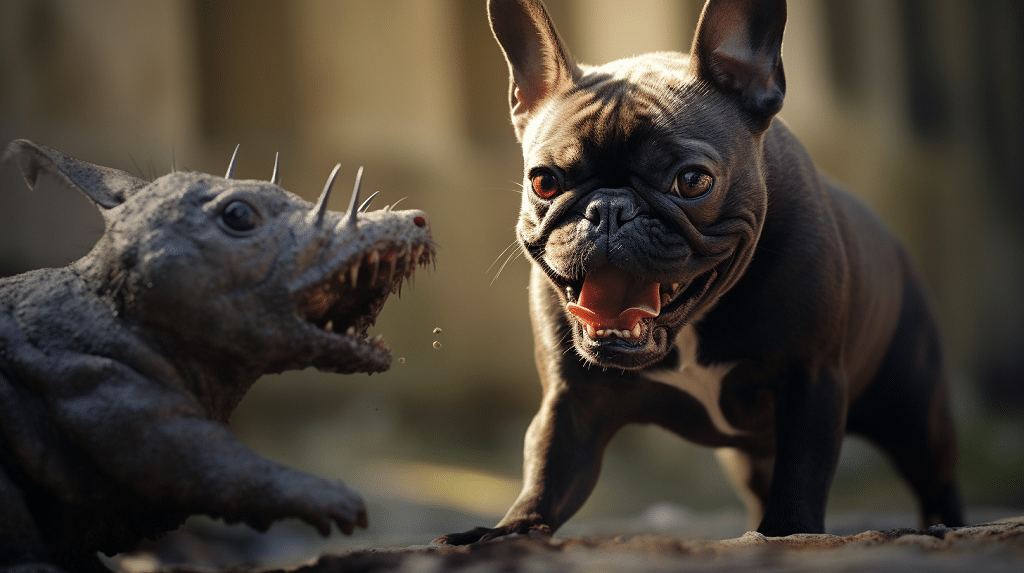What Were French Bulldogs Bred For?: You’ve seen them in parks, on social media, even in movies. But have you ever wondered what French Bulldogs were originally bred for? The history of these compact, loveable dogs shows that they were initially bred for work in the lace-making industry, before becoming popular show dogs and companion pets. Let’s delve into the fascinating journey of the French Bulldog’s rise to stardom.
The Origin of the French Bulldogs
Your interest in the origin of the French Bulldog’s breed is quite understandable as it’s a fascinating topic. Born out of England, these dogs were initially bred for ratting, a popular sport in the 1800s. Their distinctive features like compact size and bat-like ears were admired and were deliberately maintained in their breeding.
One of the most loved features of French Bulldogs is their short, smooth coat which comes in a variety of colours. Their powerful, muscular build paired with a heavy bone structure gives them a unique appearance. They’re small, but they certainly don’t lack presence.
However, they are not without health issues. The very features that make them distinctive also contribute to some of their health problems. For instance, their flattened faces, referred to as “brachycephalic”, can lead to breathing difficulties. Their compact bodies can also make them susceptible to hip dysplasia. It’s essential to be aware of these issues if you’re considering bringing one into your home.
Despite these health concerns, French Bulldogs are incredibly popular, especially among celebrity owners. Stars like Lady Gaga, Hugh Jackman, and Dwayne “The Rock” Johnson have all been spotted with their French Bulldog pets. Their popularity with celebrities has only boosted their profile, making them one of the most desirable breeds around.
The Specific Purpose for Breeding French Bulldogs
You’re now delving into the specific purpose for breeding French Bulldogs, a topic that’s important in understanding the breed’s continued popularity. French Bulldogs, affectionately known as ‘Frenchies’, were initially bred for companionship. Their sweet and sociable Bulldog Temperament makes them ideal pets for families and individuals alike.
However, breeding French Bulldogs is not without its challenges. One of the main Breeding Challenges is the breed’s physique. Frenchies have a unique, brachycephalic (short-nosed) build, which can complicate natural reproduction. Often, these dogs require veterinary assistance or Caesarean sections for birthing. This complexity has made the breeding process more labor-intensive and costly.
On top of these breeding challenges, French Bulldogs also have a high incidence of health concerns. Their short snouts often lead to breathing issues, and they are prone to skin conditions and hip dysplasia. The breed’s health concerns are a significant focus for breeders who aim to maintain the breed’s distinctive traits while enhancing their overall health.
Despite these challenges, the breed’s popularity continues to soar. It’s the breed’s loveable temperament and distinctive appearance that captivates the hearts of many. Yet, it’s important to remember that the purpose of breeding these dogs is not just about keeping up with the demand but also about ensuring the health and sustainability of the breed for future generations.
As you continue to explore the world of French Bulldogs, you’ll come to appreciate the delicate balancing act that breeders face in maintaining the Bulldog Temperament, managing breeding challenges, and addressing health concerns. It’s a testament to the love and dedication that goes into breeding these adorable companions.
The Role of French Bulldogs in the 19th Century
In the 19th century, you’d find that French Bulldogs played a significant role as companion animals for lace workers in England. These small, robust canines were not only companions but also served as ratters, keeping the lace factories free of vermin. The 19th Century Standards for these dogs were less about aesthetics and more about their ability to perform their duties.
- Bulldogs versus Terriers: Unlike the terriers, French Bulldogs were bred for their temperament and not their hunting abilities. Their role was to be a companion rather than a hunter.
- Breeding Challenges: Breeding these dogs to be smaller and friendlier was not without its challenges. Health issues such as brachycephaly were common due to their shortened snouts.
- 19th Century Standards: These standards were focused on their ability to perform their role as ratters and companions. The standards of today, which focus more on their appearance, differ greatly.
- Industrial Revolution: The Industrial Revolution played a critical role in the popularity of French Bulldogs. As lace workers migrated to France for better opportunities, they took their beloved companions with them, introducing the breed to a new audience.
Despite the differences between Bulldogs and Terriers and the breeding challenges, the French Bulldogs’ endearing qualities and their adaptability to different living conditions made them a popular choice for many. Today, while their roles have largely shifted from ratters to loving companions, the French Bulldog continues to hold a special place in many homes worldwide.

French Bulldogs and Their Involvement in Show Rings
While you’re appreciating the unique appearance of French Bulldogs, it’s important to understand that their distinct features have been further emphasized due to their involvement in show rings. Show ring standards have played a significant role in shaping the modern French Bulldog, promoting certain physical traits that make them stand out.
You’ve probably noticed their compact size, bat-like ears, and short snout. These are all traits favored in show rings, which have been emphasized through selective breeding. However, it’s not just their looks that make them a hit; Bulldog personalities are another major reason for their popularity. Known for being friendly, patient, and affable, Frenchies have a charm that’s impossible to resist.
However, being a show ring favorite isn’t without its challenges. Let’s talk about breeding challenges specific to French Bulldogs. Due to their physical characteristics, particularly their narrow hips and large heads, these dogs often require cesarean sections for birthing. Additionally, their short snouts can lead to breathing issues, a condition known as Brachycephalic Syndrome.
Despite these challenges, breeders have worked tirelessly to maintain the breed’s standard while also working to improve their overall health. They’ve focused on creating a balance between maintaining the attributes that make French Bulldogs unique, and ensuring they lead healthy, happy lives.
The Shift From Working Dogs to Companion Pets
Often, you’re seeing a shift from dogs being bred for work, to them being primarily kept as companion pets. This is especially true for French Bulldogs, who were originally bred for ratting and bull-baiting, but are now popular family pets. This shift is largely due to the domestication process, which has seen breeders lean towards dogs with more amicable temperaments.
There’s been a significant temperament shift in French Bulldogs over the years. Once known for their ferocity, they’re now adored for their friendly, sociable nature. This change in temperament hasn’t come without its breeding challenges, though. Here’s a short list of some key considerations:
- Health issues: Overbreeding can lead to health problems. French Bulldogs are known for their brachycephalic syndrome, which can cause breathing difficulties.
- Temperament: Breeding dogs for a specific temperament can be tricky. It’s not always guaranteed that a puppy will inherit the friendly, easygoing nature of its parents.
- Physical traits: Breeders often select for certain physical traits, like the French Bulldog’s distinctive bat ears. But these can come with their own challenges, like increased risk of ear infections.
- Population control: With the rising popularity of French Bulldogs, there’s a need to ensure population control to avoid overpopulation and abandonment.
In spite of these challenges, the domestication process of French Bulldogs has been largely successful. They’ve transitioned from being working dogs to beloved companions, all while retaining their unique charm and character. This shift is a testament to the adaptability and resilience of this charismatic breed.
The Modern-day Popularity and Uses of French Bulldogs
You’ll notice that French Bulldogs’ modern-day popularity has skyrocketed, making them a common sight in homes, dog parks, and even on social media platforms. This breed’s charm lies in their unique appearance and endearing personality. However, beneath the adorable exterior lie significant health issues, breed standards, and training challenges that potential owners should be aware of.
| Health Issues | Breed Standards | Training Challenges |
|---|---|---|
| Brachycephalic syndrome | Compact, muscular body | Stubbornness |
| Hip Dysplasia | Bat ears | House Training |
| Eye conditions | Short nose | Socialization |
French Bulldogs are prone to Brachycephalic syndrome due to their short nose, a key breed standard. Hip dysplasia is another common health issue. Their compact, muscular body, another breed standard, contributes to this problem. They also frequently suffer from eye conditions.
Training French Bulldogs can be challenging. They’re known for their stubbornness, which can make house training a struggle. However, with consistent, positive reinforcement methods, you can overcome these challenges. Socialization can also be tough due to their strong-willed nature, but it’s crucial for their development.
Despite these concerns, you’ll find French Bulldogs are incredibly loving and loyal, making them perfect companions. Their popularity isn’t surprising given their undeniable charm, but it’s essential to understand the breed fully. Being well-informed about their health issues, breed standards, and training challenges will ensure you’re prepared to provide the best care possible for these delightful dogs. Their needs are unique, and meeting them can be rewarding in itself, offering a bond of love and companionship that’s truly special.

Frequently Asked Questions
What Are the Common Health Problems That French Bulldogs May Face Due to Their Breeding History?
You’re asking about the health issues French Bulldogs may encounter due to their breeding history. These dogs often suffer from a variety of genetic disorders. Breeding consequences include respiratory issues, like brachycephalic syndrome, due to their compact facial structure. Also, they’re prone to hip dysplasia and certain skin conditions. It’s crucial to learn these potential health risks if you’re considering this breed as a pet.
How Do French Bulldogs Interact With Children and Other Pets?
You might be wondering how French Bulldogs interact with children and other pets. Generally, due to their Bulldog temperament, they’re known to be good companions for kids. They’re patient, rarely aggressive, and love to play. However, child safety is paramount. It’s important to supervise interactions and use proper training techniques to ensure harmonious relationships. They can also get along well with other pets if properly socialized and introduced. Always remember, each dog’s behavior can vary.
What Is the Average Life Expectancy of a French Bulldog?
You’re curious about the average life expectancy of a French bulldog, right? Well, typically they live between 10 to 12 years. This can be influenced by many factors such as their temperament, training, and exercise routines. Bulldogs are known for their calm temperament which can contribute to a healthier lifestyle. Regular and appropriate exercise, along with effective training techniques, can also promote longevity. Remember, every dog is individual and these are just averages.
What Are the Grooming Needs of a French Bulldog?
You’d think French Bulldogs would require a ton of grooming, right? Surprise! They don’t. Your Frenchie only needs brushing once a week to keep its coat healthy. Nail care? Don’t worry. A monthly trim should be enough, unless they’re excessively long. Ear cleaning? That’s a weekly task. Just be gentle and use a dog-friendly ear cleaner. So, grooming a French Bulldog is not as demanding as you might have imagined!
What Type of Diet Is Recommended for a French Bulldog?
Your French Bulldog’s diet requires careful consideration. Due to their susceptibility to food allergies, it’s crucial to feed them a high-quality, specialized kibble designed for their breed’s specific needs. Portion control is key; overfeeding can lead to obesity. Consult with your vet to determine the best diet plan. Remember, each Frenchie is unique, so what works for one might not work for another. Always monitor your pup for any adverse reactions to their food.
Conclusion
So, you’ve journeyed through the rich history of French Bulldogs, from their origin as rat hunters to their 19th-century roles as companions of lace workers. You’ve seen their transition from show ring champions to beloved pets. Today, these tiny titans symbolize loyalty, love, and companionship, their popularity a testament to their endearing personalities. They may no longer chase rats, but they’ve won something far greater – a place in our hearts. That’s the legacy of the French Bulldog.

